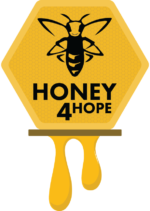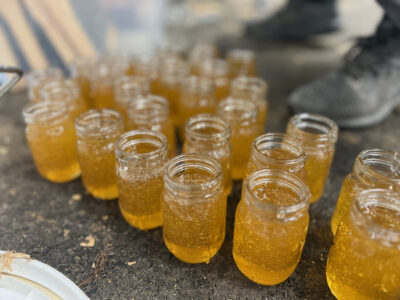Honey extraction is the process of removing honey from honeycombs so that it can be collected and prepared for consumption. The process involves several key steps, each essential in ensuring that the honey is properly extracted and preserved:
- Harvesting: This might be the most stressful part for some people, but getting in the hives is more and more natural for our head beekeeper Scott. Scott begins by identifying the frames within the beehive that contain capped honeycombs, indicating that the honey is ripe for extraction. To do this Scott used specialized tools, such as smokers and bee brushes, to calm the bees and gently remove the frames from the hive. Scott put four frames in a container to move them away from the hives for extraction.
- Uncapping: Once the frames are removed, you use a hot knife or uncapping fork to remove the thin layer of beeswax that seals the honey within the comb. This process exposes the honey for extraction. It’s a sticky mess!
- Extraction: The uncapped frames are then placed in a honey extractor, a centrifuge-like device that uses centrifugal force to extract the honey from the combs. As the extractor spins, the honey is forced out of the comb and collected at the bottom of the extractor, while the empty combs remain intact for the bees to reuse.
- Straining and Filtering: To remove any remaining particles, such as beeswax or other impurities, the extracted honey is strained through a fine mesh. This step ensures that the final product is smooth and free of debris.
- Bottling: The honey is then transferred to clean, airtight jars to prevent crystallization and maintain its freshness. This part of the process can be sticky if the honey overflows the bottle! Have a rag dedicated to wiping the jars.
The honey extraction process is critical in ensuring that the honey is safely harvested and preserved for consumption. The honey tasted great and we can’t wait to harvest more!




